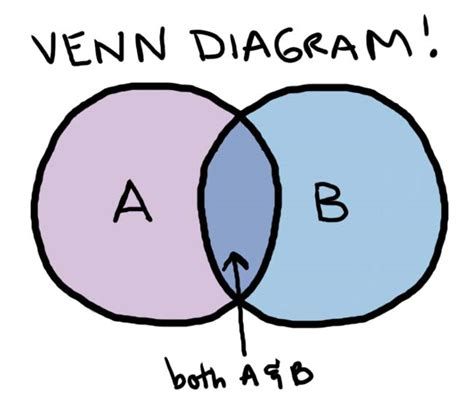Probability Diagrams and Concepts in Math AA SL
Venn Diagrams
Venn diagrams represent relationships between sets and calculate probabilities. In probability theory, these diagrams illustrate events as circles within a sample space.
ExampleConsider a class where 65% of students play soccer, 45% play basketball, and 25% play both. A Venn diagram can visually represent this information:
- Circle A: Soccer players (65%)
- Circle B: Basketball players (45%)
- Intersection (A ∩ B): Students who play both (25%)
- Outside both circles: Students who play neither sport
Using this diagram, we can easily calculate that 85% of students play at least one of these sports: P(A ∪ B) = P(A) + P(B) - P(A ∩ B) = 65% + 45% - 25% = 85%
TipWhen using Venn Diagrams, start determining the number of objects with the most conditions (the inner most intersection) and work backwards. You avoid dealing with inclusion-exclusion principle and only have to work with the most basic cases,
Tree Diagrams
Tree diagrams are particularly useful for visualizing sequential events and calculating conditional probabilities. Each branch represents a possible outcome, and probabilities are multiplied along paths to find combined probabilities.
ExampleA bag contains 3 red balls and 2 blue balls. Two balls are drawn without replacement. The tree diagram would show:
1st draw:
- Red (3/5)
- Blue (2/5)
2nd draw (given Red first):
- Red (2/4)
- Blue (2/4)
2nd draw (given Blue first):
- Red (3/4)
- Blue (1/4)
To find the probability of drawing two red balls: P(Red and Red) = (3/5) × (2/4) = 3/10
Sample Space Diagrams
Sample space diagrams, often represented as grids or tables, show all possible outcomes of an experiment. They are particularly useful when dealing with two or more independent events.
ExampleRolling two dice can be represented in a 6x6 grid. Each cell represents a possible outcome. To find the probability of rolling a sum of 7:
P(sum of 7) = Number of favorable outcomes / Total number of outcomes = 6 / 36 = 1/6
The favorable outcomes are (1,6), (2,5), (3,4), (4,3), (5,2), and (6,1).
Combined Events
The probability of the union of two events A and B is given by:
$P(A \cup B) = P(A) + P(B) - P(A \cap B)$
In the set of $A$, there are outcomes that are also in $A \cap B$, by there are also the same number of outcomes that satisfy $A \cap B$ which are also in $B$. Therefore, it is necessary to subtract $ P(A \cap B)$ from the overall probability to ensure that they are not over-counted.
NoteThe term P(A ∩ B) is subtracted because elements in the intersection would otherwise be counted twice in P(A) + P(B).
